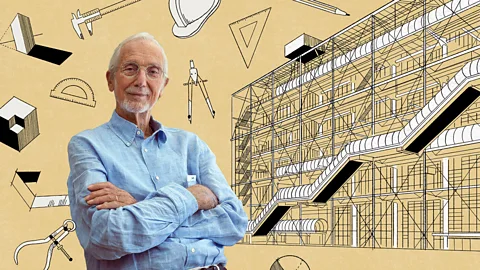 Emmanuel Lafont/ Enrico Cano
Emmanuel Lafont/ Enrico CanoThe daring, radical Pompidou Centre was derided by many when its design was first unveiled – but it has continued to affect the structure of public buildings ever since. Because the constructing approaches a significant renovation, its co-creator Renzo Piano recollects the furore.
This summer time, the Centre Pompidou will shut for 5 years, as Paris’s standard polychrome landmark undergoes adjustments necessitated by present necessities by way of well being, security and vitality effectivity. French studio Moreau Kusunoki Architects, Mexican follow Frida Escobedo Studio and French engineer AIA Life Designers will undertake a significant overhaul of the six-storey arts centre, containing Europe’s largest museum of contemporary artwork. Its renovation will add usable flooring area, take away asbestos from all facades, enhance fireplace security and accessibility for individuals with lowered mobility, and optimise vitality effectivity.
 Getty Photos
Getty PhotosSo far as potential, the unique constructing will probably be conserved because it was earlier than. To do in any other case could be thought of cultural sacrilege – after all of the Pompidou’s identification is indivisible from its authentic architects, Renzo Piano, and the late Richard Rogers. The duo arrange their follow, Rogers + Piano, in 1970, and submitted a design to a prestigious competitors instigated in 1971 by Georges Pompidou, France’s President from 1969 till 1974. Its jury was headed up by Jean Prouvé, a metalworker and self-taught architect, and included such stellar architects as Philip Johnson and Oscar Niemeyer. Piano and Rogers’ design was chosen from 681 competitors entries.
The consequence caught the duo, then unknowns of their 30s “with Beatles haircuts”, as Piano places it, unexpectedly: “We did not suppose we would win, we entered the competitors for pleasure,” the Italian architect, now 87, tells the BBC. “We by no means deliberate to create a revolutionary constructing. Our concept was a museum that will encourage curiosity, not intimidate individuals, and that will open up tradition to all.”
In truth, the duo’s insouciance might assist to clarify the constructing’s uninhibited boldness, flamboyance and ludic high quality. Its structural parts and companies have been positioned on its facades, permitting it to maximise its inner, open-plan areas – and prompting the futuristic construction to be dubbed the world’s first “inside-out” constructing. Its exoskeleton of tubes and periscope-like pipes have been playfully colour-coded: blue for air air-conditioning, yellow for electrical energy, inexperienced for water and crimson for pedestrian circulation. Guests streamed up escalators – encased in clear tubing affording panoramic views – that have been designed to strengthen the museum’s connection to town.
“Our concept was for the constructing to take up solely half the location, permitting for a welcoming out of doors place – a piazza – the place individuals may meet,” says Piano, whose different tasks embody the California Academy of Sciences in San Francisco (rebuilt in 2008), the Shard (2012) in London, and the just lately accomplished Paddington Sq., additionally within the UK capital, a mixed-use constructing and public sq.. “Our credo was a spot for all individuals – for the poor and wealthy, the younger and outdated.”
Tradition Shifters
Tradition Shifters is an interview collection during which high-profile creatives replicate on a piece of theirs which made a huge impact on the world. Learn extra articles from the collection here.
The Pompidou’s transparency, accessibility and adjoining piazza chimed with new concepts about democratising tradition. “Road theatre and concert events in public areas have been rising in reputation on the time,” says Piano.
Contained in the constructing, guests had entry to the Bibliothèque Publique d’Info – Paris’s first free public library – the Musée Nationwide d’Artwork Moderne and the Institut de Recherche et Coordination Acoustique/ Musique (IRCAM), devoted to analysis of music and sound.
Piano and Rogers’ profitable entry provoked consternation and fury when it was introduced at a press convention: “The room was packed,” remembers Piano. “Richard and I have been standing in the course of the room being heckled. We felt elated but horrible on the identical time,” says the architect. “Some individuals have been shouting, ‘Why have you ever designed one thing so horrible?’ ‘Why are you might be destroying Paris’s historic centre?'”
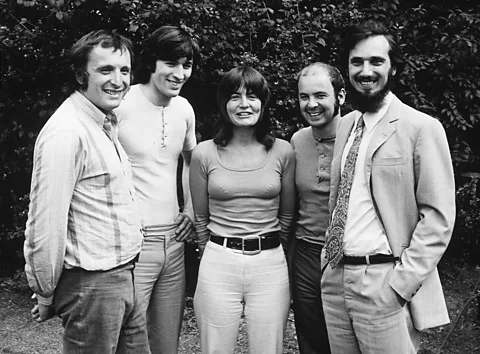 Centre Pompidou
Centre PompidouThough shocked to have received the competition, Genoa-born Piano grew up feeling structure was his future – aged 18, he advised his father he needed to be an architect. Nonetheless in dialog his method is humble, not entitled. Born right into a household of builders in Genoa, he beloved watching his father’s work take form. Maybe his childhood expertise of seeing buildings materialise efficiently made him really feel that structure is open to all prospects. “Constructing is a ravishing gesture,” he as soon as advised The Monetary Occasions. “It is the other of destruction… particularly when you find yourself creating buildings for individuals as a result of they’re civically necessary.” In 1981, Piano based the Renzo Piano Constructing Workshop (RPBW), with workplaces in Genoa and Paris, led at the moment by 11 companions (within the spirit of a collective). In 1998, he received the Pritzker Structure Prize.
The Plateau Beaubourg in central Paris – a stretch of wasteland occupied by a carpark – was the location chosen for the brand new Musée Nationale d’Artwork Moderne (previously housed within the Palais de Tokyo in Paris’s haut-bourgeois sixteenth arrondissement). “It was a spot ready for one thing to occur,” says Piano.
A second of change
France’s social and political local weather on the time, nonetheless rebellious following the tumultuous occasions of Could 1968, was conducive to the creation of a constructing as disruptive because the Centre Pompidou, acknowledges Piano: “In Britain, society was being revolutionised by [designer] Mary Quant and the Beatles. The identical was taking place in Paris.” The Centre Pompidou was partly impressed by the ultra-pop structure of experimental London-based structure collective Archigram.
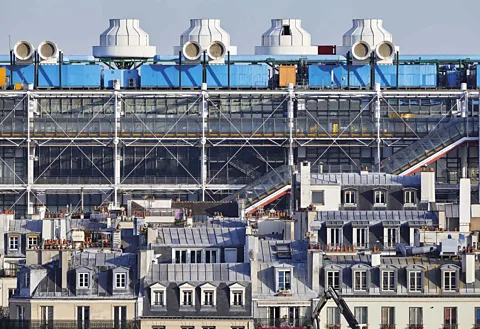 Denancé, Michel
Denancé, Michel“The concept France ought to have a ‘Maison de la Tradition’, bringing collectively artwork, cinema, music and literature in cities was first invented by André Malraux [novelist, art theorist and France’s first Minister of Cultural Affairs]. Pompidou was very supportive, too. I actually consider that main shifts in structure are solely potential when you have a great consumer. George’s spouse, Claude, too, was a superb girl.”
Pompidou, like Claude, was keen about up to date artwork and design. In 1972, they invited Pierre Paulin, a designer identified for his space-age period furnishings, to create new interiors for the non-public house of the Elysée Palace, the French presidents’ official residence. The outcomes have been radically trendy – the partitions of the lounge, eating room and smoking room have been lined to cocooning impact with wool and polyester panels that obscured the residence’s neo-classical splendour. Partitions have been hung with work by Robert Delaunay and different modernist artists.
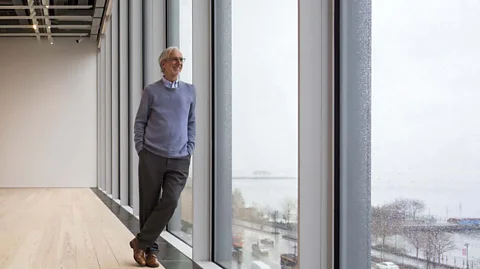 RPBW Architects
RPBW ArchitectsOne impetus behind these efforts to supply Paris with a prestigious museum was that France had misplaced its status because the world’s pre-eminent centre of avant-garde artwork. “It’s my passionate want for Paris to have a cultural centre like those they have been creating within the US,” Pompidou told Le Monde newspaper in 1972. “It will likely be each a museum and centre of creation, the place the visible arts take up residence with music, movie, books and audiovisual analysis.”
Initially, reactions to the Centre Pompidou, often in comparison with an alien spaceship, have been typically extraordinarily unfavorable. “Taxi drivers used to say to me: ‘Regardez!’ earlier than launching right into a tirade in opposition to the constructing. With a lot hostility, I needed to maintain a low profile amongst strangers,” says Piano. The constructing, derisively likened by many to an “oil refinery”, was the goal of numerous lawsuits. “We have been sued so typically – as soon as on the grounds that Prouvé wasn’t a certified architect,” he recollects. The French press initially lambasted the constructing. “Paris has its personal monster, similar to the one in Loch Ness,” scoffed Le Figaro.
“Someday Richard and I have been exterior the constructing, as but unfinished. We noticed a lady scuffling with an umbrella that had turned inside out within the wind and Richard rushed over to assist repair it. When he talked about that he was one of many constructing’s architects, she jokily mimicked hitting him with the umbrella as if to counsel he was a naughty scoundrel.”
But after the constructing’s opening in 1977, Parisians quickly started to understand the museum – now one among Paris’s most visited public establishments, that ranks behind solely the Louvre and Musée d’Orsay by way of customer numbers.
It additionally conjures up architects at the moment. “The Centre Pompidou, radical on completion, has continued to affect the design of public buildings ever since,” says Hugh Broughton, founding father of London-based Hugh Broughton Architects, who finds qualities in it aside from its famously high-tech idiom. “It is an amazingly courageous, beneficiant constructing whose massive public area promotes congregation, avenue theatre and the very best high quality people-watching. Its core idea – open-plan flooring plates supported by peripheral construction and companies – attracts upon medieval rules of chateau buildings, and combines this with an Arts and Crafts method that makes a advantage of building as an aesthetic medium. The result’s a constructing which is dynamic, inviting, egalitarian, clear and has superior views – all the most effective attributes of nice structure. It modified the best way an entire technology of architects take into consideration buildings – inserting their customers at centre stage.”
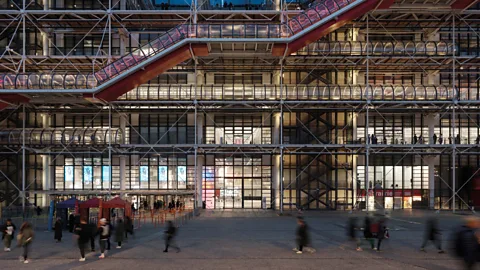 Cano, Enrico/ RPBW Architects
Cano, Enrico/ RPBW ArchitectsPiano can also be identified for harnessing gentle in his tasks to ethereal impact, as is the case with the Shard, which may appear to vanish in sure gentle circumstances attributable to its glass pores and skin. Architecture critic Nicolai Ouroussoff has said of his works as an entire: “The serenity of Renzo Piano’s greatest buildings can virtually make you consider we stay in a civilised world.”
For Piano, what’s the primary architectural legacy of the Pompidou Centre? “The constructing is proof that tradition would not undergo from being extra public. It is a spot the place individuals collect primarily. It brings collectively artwork, life and tradition – not tradition with an enormous C however tradition with a small c. When it opened, it introduced tradition to all, and made town a greater place for it.”





